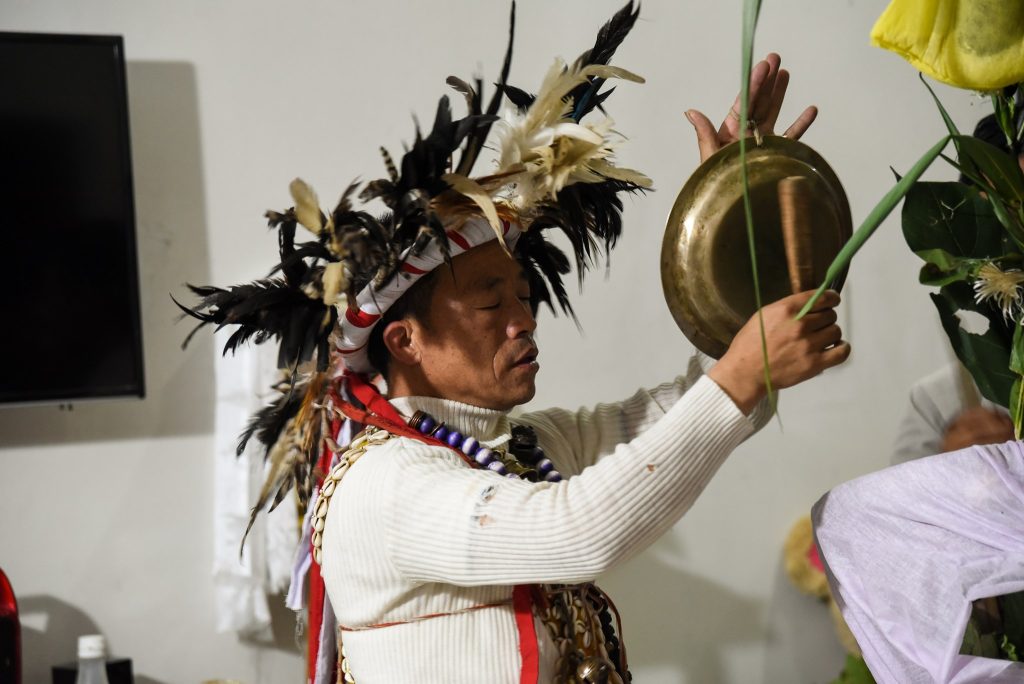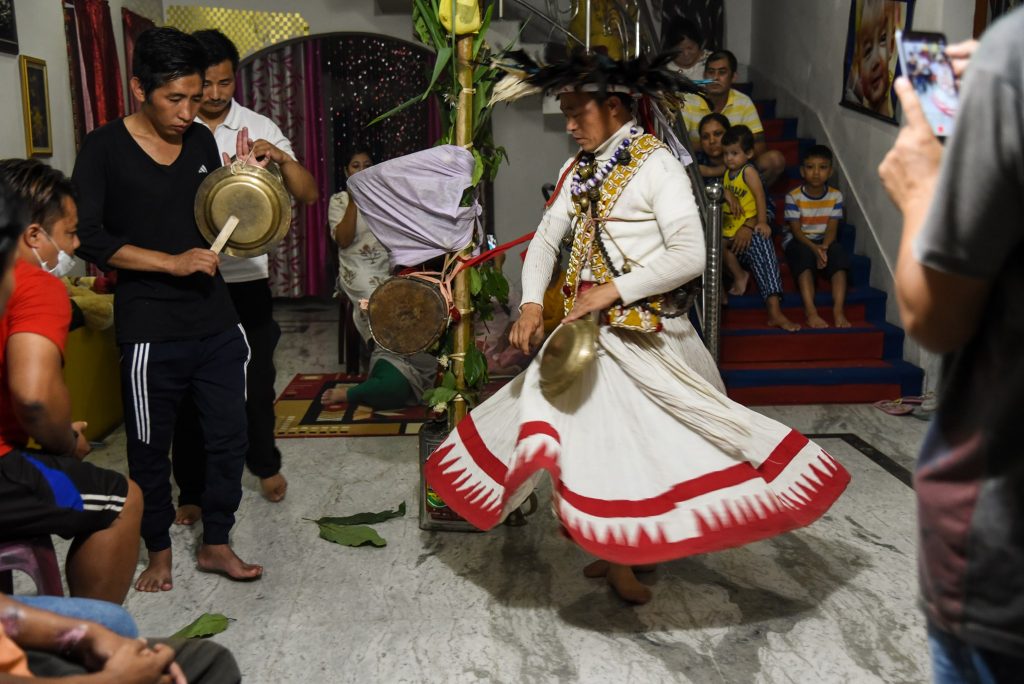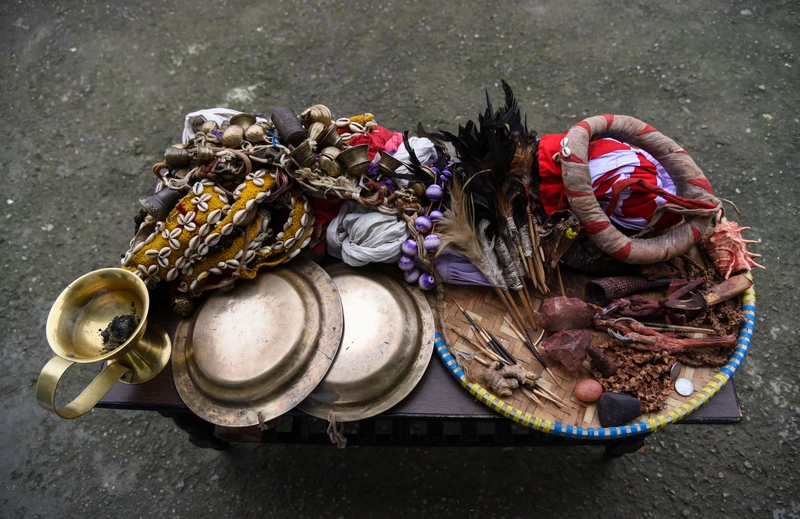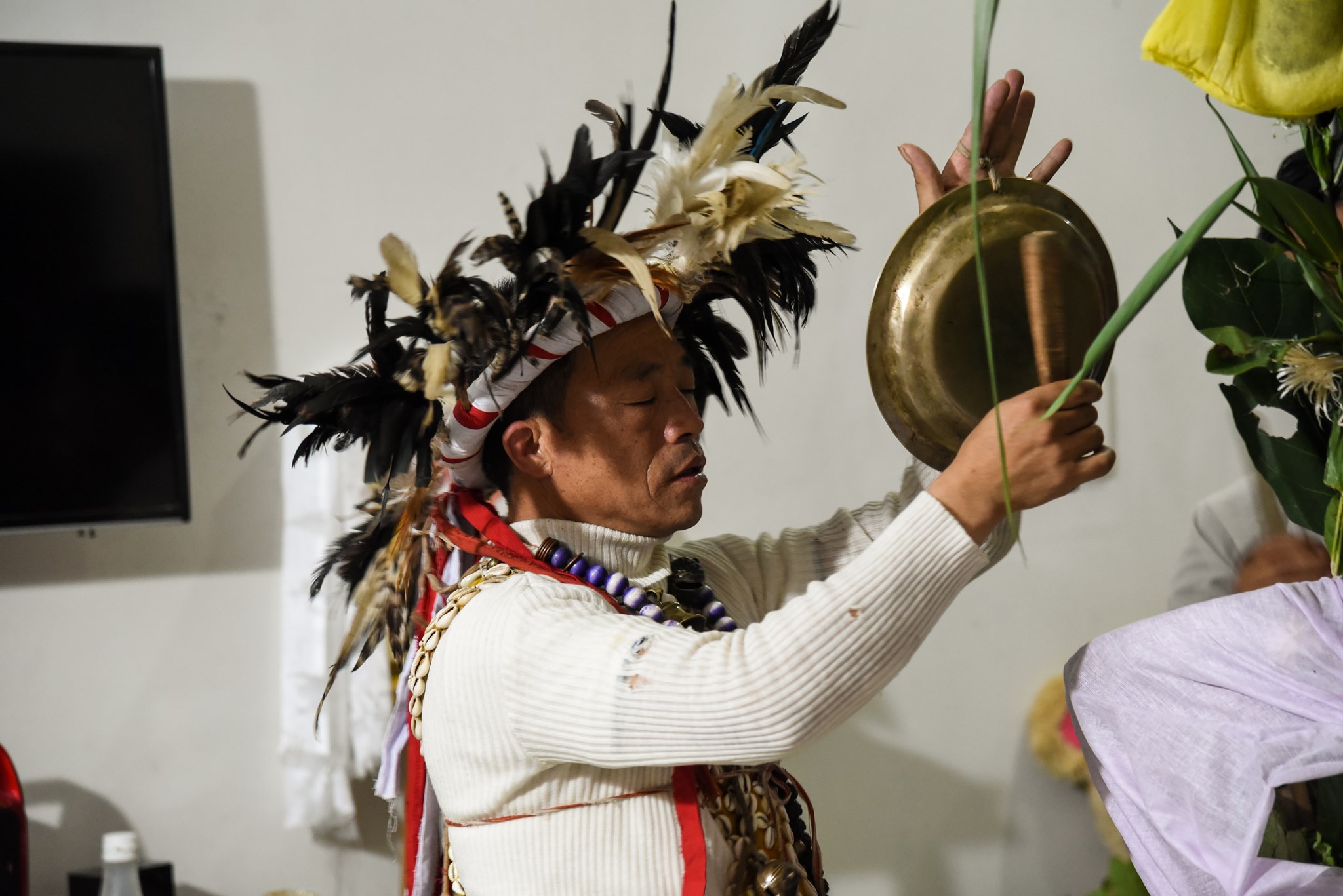BY BUDDHI L. KHAMDHAK, DEPARTMENT OF LIMBU, NBBGC, TADONG, GANGTOK
Narrating the Origin, Social Order and Rituals
By Buddhi Lal Khamdang
PART-II
In Khong Pokma mundhum; origin of coffin, when brother, Mangai Lorammeppa throw punch of flower to his sister, Irere Indhindrukma due to anger, she suddenly falls ill; leading her death. When news spread in the village, the assemble was summoned and brother was penalised with ‘samjik samban’. In Limbu culture, both brother and sister are considered as an important counterpart, ‘mangenna’ [protector]; without which one cannot exist or vice versa, empowering and protecting each other. Since then, in the council, it was decided that no exchange or throwing of flower and touching [kicking with leg]; toes/feet between brother and sister allowed, failing which punishment is implied. Even today, in Limbu culture, both brother and sister is equal and important; and exchanging or throwing flower and touching with leg or toes between brother and sister is not permitted. The violation of such customary law leads to samjik samban and khumding punishment. Besides, in Limbu society, the position and status of women is considered to be very significant; they occupy the position of deity, saviour, mother, sister. As such discrimination, and domination is considered as violation of tradition and illegal.

In Tetlara Lahadongna and Suhangbemba mundhum, when Lahadongna continuously tortured and ill-treated kigidongna khya [first tamed dog], kicked and bitten up with broom, one day the dog complained Tagera Niwaphuma; explained how he was ill-treated and tortured for no reason even he was performing all his responsibilities and duties at Lahadongna’s dwelling. Thereafter Lahadongna was called and directed not to ill-treat and torture; kick and touch with broom failing which major punishment is enforced for creating sin. Even today, touching or kicking the dog with leg by the women and beating with broom is considered as ‘sikyam’, great sin and forbidden.
PART: III
Yehang Mundhum in Rituals:
Limbu mundhum not only describes about the creation and social order, but also explains the reason about why rituals are performed. Yapon Pokma mundhum , narrates that when Mujikna Kheyongna descended to the visible world from the invisible world to pay visit to her off springs, she found everyone starving for survival from the grip of hunger and famine caused by the drought. When she saw such sufferings and problems faced by her grand-children in the visible world, she felt so sad and disgraced. So to save them from such social phenomenon, immediately returned to the invisible world to seek blessing and suggestion from Tagera Niwaphuma for the protection of her off springs from such grip of famine and starvation. After seeking the advice from Tagera Niwaphuma, she once again descended to the human world with the handful of food grains. She advised each and every grand-child to sow the grains in their fields in different seasons. Following her instruction, the grand-children sown the food-grains in the fields and when seasons changed, every food grains were ripened in bumper. The grand-children harvested and started consuming. These food grains ripened in their respective fields saved everyone’s life from starvation and hunger. Due to this reason, ritual for offering newly harvested food-grains to the household deity, “Yuma Mang” is still carried out in Limbu community in every harvesting seasons.

In Nahen mundhum and Sakmra Pokma mundhum , Sora-ing Kangla-ingma, rapidly advised her son Sawagen Yukpung Kemba not to fall in love in case if he comes across with any of the beautiful maidens found in the majestic jungle while going for hunting. But Sawagen Yukpung Kemba turned his deaf ear to his mother’s advice. As such when he goes for hunting towards southern direction of the dwelling, met Yosulung Phiyamlungma and fell in deep love. Thereafter when he reached to the northern direction again come across with another beautiful maiden, Thosulung Mukumlungma, fell in love. As a result, when both of the maidens come to know that Sawagen Yukpung Kemba was engaged with both of them [Yosulung Phiyamlungma and Thosulung Mukumlungma] residing in the south and north directions, they avoided Sawagen Yukpung Kemba due to jealousy. So both the maidens were so annoyed, they not only discarded Sawagen Yukpung Kemba but also they denied him shelter, food, love and care. This caused him disgraced, hungry and finally death. Since according to Limbu mundhum, Sawagen Yukpung Kemba died due to curse, jealousy and envoy of two ladies. Even day, Limbu tribe consider curse, jealousy and envoy as evil which can cause harm, obstruction, and damages to the family or Limbu community, and ritual called “pando”, “nahen” and “sakmra” are performed.
Similarly, Nehangma Mundhum is also worth mentioning as it plays significant in the Limbu culture. According to the said mundhum, one day Mangyangbung, brother of Tigedimma left the dwelling with the promises of never coming back again after he was defeated in the completion by Tigedimma. He decided to reside in the majestic cave of the dense forest. But due to the distress and frustration he suffered from illness very seriously. On hearing the message, Tigedimma set out the search for her brother and brought him back to the dwelling, performed Nehangma to save the life of her brother from sickness caused by distress and frustration. Eventually when his sister Tigedimma performed such ritual ceremony for her brother, Mangyangbung could be saved from the grave of sickness and death. Till the present day, the Nehangma ritual is performed for the head of the family as set out by the Nehangma mundhum.
In Khong Pokma Mundhum, after Ireray Indhindrukma died, her corpse was dumped just beneath the waterfall by her brother, Manga-e Larammeppa. When the death body started rotting, bad smell spread all over the villages; caused epidemic. The people of the locality complained; therefrom when the villagers and Manga-e Larammeppa went to the spot to recover the death body, they were suddenly frightened and lost their soul. As a result, they fell sick. Latter, when the villagers approached Tagera Niwaphuma, they were told that the living soul has been taken away by the death soul which caused them sick; advising them to get their soul extracted immediately after the final death ritual of the diseased person. Even today the Limbu tribe perform khongsing kakma ritual in every final of the death ritual. The souls of the living people are extracted and separated from the death soul during death rituals. In Limbu tribe, reason for performing rituals are being precisely explained by the mundhum. Those rituals which are stated above and performed are only few instances which still prevail in Limbu community.

Next mundhum is about the pregnant women. Tigenjongna when she was conceived fell sick and unwell. One day she approached Tagera Niwaphuma and explained her problem. Tagera Niwaphuma told her that she is sick due to problem caused by the deities; ‘lokphagen sihkim mang’, ‘thosu singla mang’ and ‘yosu wame mang’ therefore, unless ritual, ‘sapok chomen’ is performed by the Limbu shaman, she would face difficulties in delivery and remains unwell. Tigenjongna, after she came back to her dwelling, called ‘sudayume’ and Limbu shaman to perform special ritual, ‘sapok chomen’. After the sapok chomen ritual was performed, she recovered and her delivery was eased. So everyone who witnessed the ritual learned that when women are pregnant, performance of ‘sapok chomen’ is necessary and everyone in the village started performing the ritual. Later in Limbu society, when women conceived, the tradition of ‘sapok chomen’ became the way of social life. Even today, for the protection of pregnant women against the evils and deities; cause harm to her and for the easy delivery of the child ‘sapok chomen’ is performed in the Limbu community.
Conclusion:
In Limbu society, mundhum forms as important part of rituals or without mundhum no rituals can be performed or practised, rather understood among the Limbu community. The Limbu shamans or ritual specialists; Phedangma, Samba, Yetchamba, and Yeba/Yema who are the main source of such mundhum act as medium or mediator between visible and invisible world, between ancestral and physical, and in between deities and human being. Hence, the mundhum cannot be overlooked by the scholars; needs thorough investigation and understanding through practical knowledge. The text of mundhum can be understood only with the practice of mundhum; as mundhum has emotional attachment with ritual practice and community. The recitation of mundhum as part of any Limbu ritual; recitation of mundhum and practice has to go hand to hand.
BIBLIOGRAPHY:
-Kluckhohn, C., (1942), “Myths and Rituals: A General Theory”, Harvard Theological Review 35 (1942), 45–79;
-Tylor, E. B., (1871), Primitive Culture, 2 vols. (London, 1st ed., 1871),
– Frazer, J.G., (1890), The Golden Bough, 1st ed., 2 vols. (London, 1890)
-Chemjong, I.S., (2003), History and Culture of the Kirat People, Pipin Kanchan Printing Press, Bagbazar, Kathmandu, Nepal.
-Gurung, M.M. & Lama, R. P. (2004), Sikkim Study Series, Culture, Vol-III, Part-A, IPR, Govt. of Sikkim, Kwality Stores, Gangtok, Sikkim.
-Kainla, B., (1994), Nahen Mundhum, Dimdara Offset Printing Press, Kathmandu, Nepal.
-Kainla, B., (2002), Choit Mundhum, Kipodhkasan Centre, Baneswar, Kathmandu, Nepal.
-Kainla, B., (2011), Comparative Study of Limbu Folk Deities, Journal of Nepalese Literature, Art and Culture, Nepal Academy, Kamaladi, Kathmandu, Nepal.
-Kainla, B., (2014), Khapunam Nellonghangma Mundhum Nu Luplinama Wadonnama Mundhum, Subhadeep Printing Press, Kathmandu, Nepal. Kainla, B., (2014), Lahadona-Suhamphemba Mundhum, Subhadeep Printing Press, Kathmandu, Nepal.
-Kainla, B., (2014), Mujikna-Kheyongna Mundhum, Subhadeep Printing Press, Kathmandu, Nepal.
-Kainla, B., (2014), Namsami-Kesami Mundhum, Subhadeep Printing Press, Kathmandu, Nepal.
-Kainla, B., (2014), Panajaiba Mundhum, Subhadeep Printing Press, Kathmandu, Nepal.
-Khamdhak, B. L., (2009), Yakthung Mundhum, Popular Printing Press, Bidhan Road, Siliguri, West Bengal.
-Sagant, P., (1976), Becoming a Limbu Priest: Ethnographic Notes, in John T Hitchcock and Rex
-Subba, C., (1995), Culture and Religion of Limbus, Bani Offset Mudranalaya, Teku, Kathmandu, Nepal.
-Subba, J.R., (1999), The Limboos of Eastern Himalayas with Special reference to Sikkim, Ambica Printing Press, New Delhi.
Buddhi L. Khamdhak works as an Assistant Professor at the Department of Limbu, NBBGC, Tadong. His research interest includes state politic in Sikkim, Limbu indigenous knowledge, Limbu mythology (or mundhum), and language and literature. He has more than eleven books to his credit focusing on Limbu literature and narrative production. His latest one is ‘Sister’s Voices’ (Poetry book; Limbu version). His Limbu poems latter translated into English, are taught at the State University of Michigan, USA. Khamdhak has also been a Visiting Lecturer for teaching Limbu language at the University of Vienna and also translation work on Limbu mundhum at Centre for Interdisciplinary Research and Documentation of Inner and South Asian Cultural History (CIRDIS), Austria, 2019.

